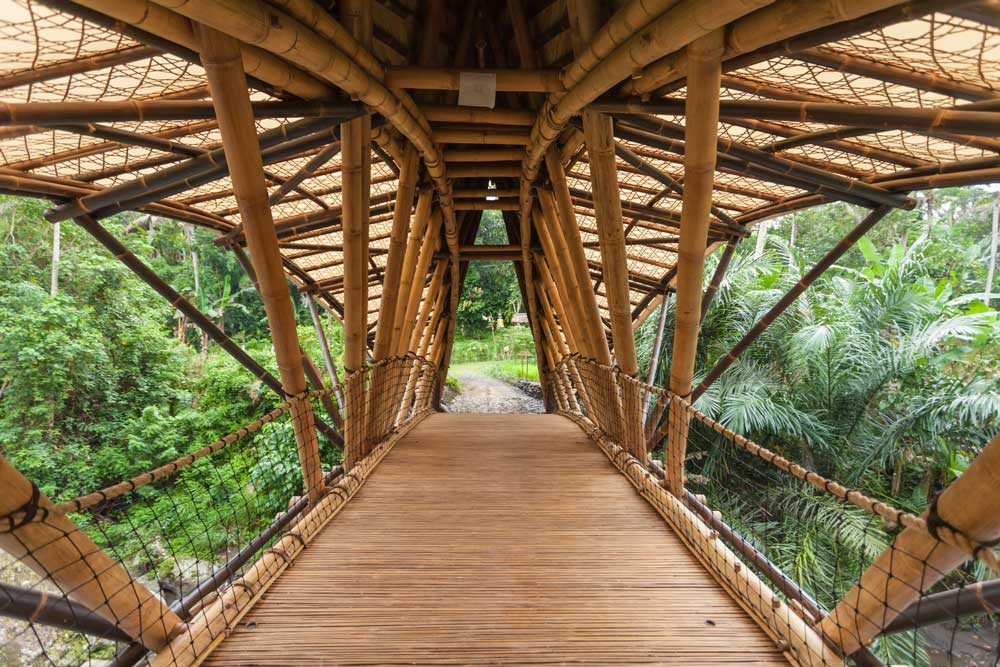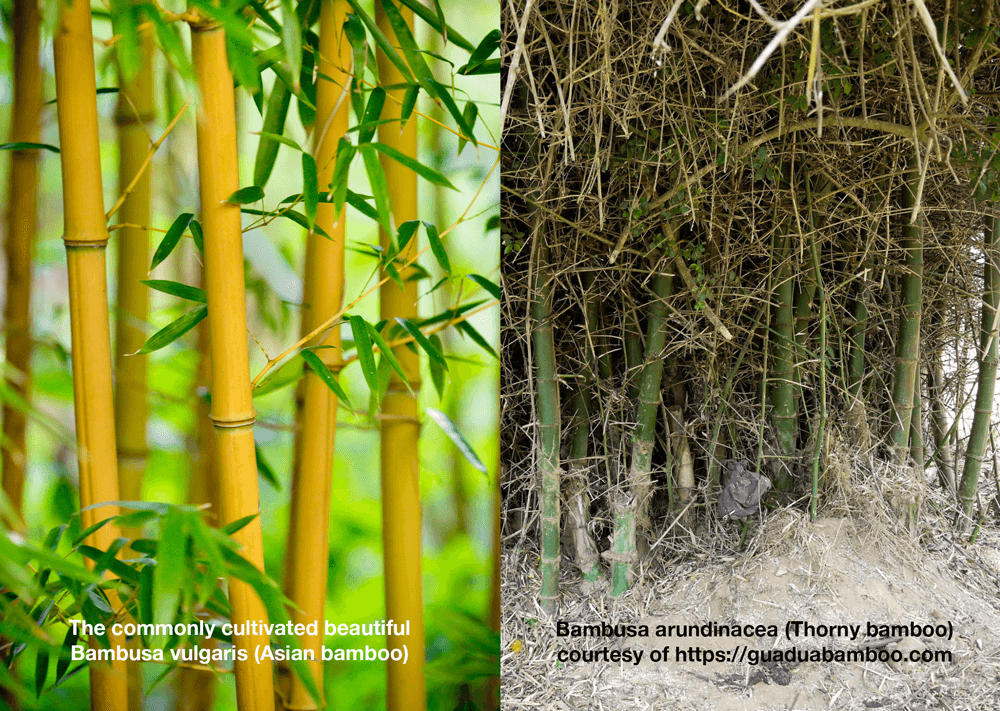I once lived on a farm near Mt Warning, where a majestic clump of yellow stemmed bamboo grew up over 20 feet tall. It grew near the top of a hill, so in a storm when the big winds would rush up the valley, the bamboo would bend right over and nearly touch the ground then bend back up again. Impressive.
Just watching this capacity for bending and yielding gives clues about the homeopathic remedy Bambusa arundinacea and there’s a mine of other information to be gained by being near it on a daily basis. It was ever-present up the hill while I was down the hill chasing the chooks.
What did I learn about the plant when I lived in northern NSW?
- It’s an insanely useful plant
- Despite being hollow, it is really strong
- A piece of bamboo makes an elegant wind chime because it’s hollow
- You can use it to make beautiful but practical bean trellises and fences
- It grows surprisingly fast (not like trees)
- It’s a noisy plant
- The bamboo canes creak and knock together and sound like a female voice wailing
- It sheds its leaves so that they lie thick on the ground in a soft pile and are great mulch
How else can we get an understanding of the plant? There’s a lot to be learned from different cultures in countries where it grows around the world.
The nature of bamboo
Bamboo is actually a species of grass but grows like a tree. In Asian countries bamboo is a part of daily life with a myriad of practical ways of being used: water pipes to irrigate, scaffolding, building, food, raw material for paper and receptacles for food and drink. Extracts are used in Asian traditional medicines to treat various inflammatory conditions.
Bamboo has been used to make dwellings and other objects long before 7,400 years ago. Carbon dating of a bamboo mat unearthed from what is now called Hunan province is the oldest evidence of its use in China. Most bamboo buildings over time disappear without a trace in true sustainable style.
The Green School in Bali has buildings constructed primarily from renewable resources including bamboo. They set themselves up to act as a model for sustainability and a centre for experimentation, innovation and solutions.

Bridge made from Bamboo at the Green School in Bali
In Australia it’s regarded as something of a symbol of eastern mysticism and elegance. Music played on a bamboo flute helps you to enter a trance. We are awed by the beauty of the drooping bamboo leaves portrayed in countless Japanese ink paintings and the eerie grace of giant bamboo stands in movies. This beauty makes it easy to forget that fast growing bamboo was used for torture and that some species of spreading bamboo are a total pest. In Australia, it is a part of the sustainability trend being used for: flooring; paper; toilet paper; cutlery; sheets; clothing etc. especially since it grows three times as fast as eucalyptus and can be harvested four times as much. It is known as the fastest growing plant on earth with one species able to grow an incredible 47 inches in a single day.
In China people identify with bamboo as a symbol of desirable personality characteristics – it stands for elasticity, endurance and perseverance. The stem bends and does not break. The leaves are moved by the wind but don’t easily fall. Bamboo yields to the storm and survives.
Bamboo grows all over the world, including both really cold and really hot countries. All continents have native species, except for Antartica and Europe, where non-native species still grow.
The yellow bamboo Bambusa vulgaris certainly fits our general expectations about the beauty of the plant. But it is just one of 1,600 or so types of bamboo on the planet and the actual medicinal bamboo plant used to make the homeopathic remedy is Bambusa arundinacea called Giant thorny bamboo. It lives up to its name by creating an impenetrable wall of long hooked thorny branches. Once established in the ground it will replace any form of fencing. It is virtually impossible to harvest. Far from beautiful or elegant compared to the yellow bamboo I had growing on the farm.
The two types are different in the extreme and that becomes important when studying the homeopathic remedy, on the one hand tall, elegant, graceful and on the other hand impossible, impenetrable and thorny.

Studying the nature of the plant and its long history as a traditional medicine, is akin to studying the Doctrine of Signatures: gaining clues about the spectrum of uses of this plant. These are invaluable in understanding both the traditional medicine and the homeopathic medicine but not definitive until they are backed up by research.
Bamboo as a traditional medicine
The whole plant contains high levels of silica. The main antioxidants in bamboo leaves and shoots are phenols, vitamin C & E and mineral elements such as selenium, copper, zinc, iron and manganese. The roots, leaf and shoots are a traditional medicine which is known for:
- anti-inflammatory actions
- anti-oxidation
- liver protection
- oedema
- hypertension
- diabetes
- improving the skin
Bambusa the homeopathic remedy
The remedy came to life in 1994 when Bernd Schuster conducted the research called a proving. His work gave us the indisputable symptoms to look for in a person who may benefit from the remedy Bambusa arundinacea. This powerful work recorded the statements people make, their feelings and physical symptoms and thereby formed a symptom pattern or ‘remedy picture’ which is specific to bamboo.
Bamboo the plant is characterised by elasticity, endurance, persistence and powers of survival. Schuster found that the person who will benefit from Bambusa has a lack of elasticity in terms of tension, tightness or stiffness, but also at the other extreme they may have excessive looseness in the form of laziness, day-dreaming and hypermobility of the spine. This was seen in the study at all levels, from the psychological to the physical sphere.
The remedy can be needed when a mother makes statements such as, “I feel as if my emotional foundations are lacking. I feel deserted and no one asks if they can help me. I would like to run away but I’m stuck. I am anxious about what’s in store for me over the next few years. There’s a huge mountain to overcome. I find too much closeness in a relationship to be suffocating so that I make a rod for my back. I need more support. I can’t handle my child.”
The proving research showed that there was an important theme coming through. There was a search for support emotionally, especially in issues to do with looking after children when the father (or mother) was “not present enough”. Physically there was a need for support in the back with pain, stiffness and changes to the spine along with a tendency to lean against things and to prop up the head.
It appears that the time after birth for mother or father may often give rise to a need for Bambusa. It is a time of high demands on the whole family. The family situation is turned upside down, accompanied by sleep deprivation, being always on call, breastfeeding and worry about the child’s wellbeing. The mother often feels stressed, strained, tortured, overwhelmed and underhelped. She feels trapped with her roots firmly in the ground, she stiffens up, she can only yield to the demands made of her and her energy goes into surviving. “Yield and survive.” The resulting ineffectual search for help and support is the central idea of Bambusa on the emotional level. The bamboo plant is often used as a foundation, providing structure and stability. Bamboo is hard, tough, indestructible, giving protection against typhoons and can help to support and stabilize the new mother. The remedy will work most effectively when the actual seeking of more support is actively encouraged from the partner, friends, chiropractor, counsellors and support groups. This is especially true since a major part of the action of the remedy is to allow the person to finally ask for help, to take time out or more importantly to accept help when it is offered.
Emotionally and physically the remedy may help with post-natal depression, post-natal exhaustion, torticollis, inflammatory conditions, acne, flaking skin, back pain, sciatica, Scheuermann’s disease, ankylosing spondylitis (bamboo spine) and rheumatic disorders where stiffness is the main complaint.
A homeopath will take a full case before prescribing the Bambusa remedy and will differentiate it from the other similar remedies for mothers (and others) such as Sepia, Silica, Pulsatilla, Rhus tox, Carcinosin, Calcarea carbonica, Belladonna, Phosphorus and Tuberculinum.
This is an edited version of an article Bending Over Backwards to Help previously published along with the proving on the website of Bernd Schuster and in WellBeing magazine in Australia.
- Filling in the Gaps: A Homeopath’s Tour of a Dental Technician Lab - 08/11/2024
- Homeopathy surge worldwide - 11/08/2024
- Autism is helped by several different styles of homeopathy - 07/05/2024



